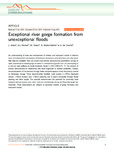Exceptional river gorge formation from unexceptional floods
| dc.contributor.author | Anton, L | |
| dc.contributor.author | Mather, Anne | |
| dc.contributor.author | Stokes, M | |
| dc.contributor.author | Muñoz-Martin, A | |
| dc.contributor.author | De Vicente, G | |
| dc.date.accessioned | 2016-10-18T13:44:38Z | |
| dc.date.available | 2016-10-18T13:44:38Z | |
| dc.date.issued | 2015-08-05 | |
| dc.identifier.issn | 2041-1723 | |
| dc.identifier.issn | 2041-1723 | |
| dc.identifier.other | 7963 | |
| dc.identifier.uri | http://hdl.handle.net/10026.1/6569 | |
| dc.description.abstract |
An understanding of rates and mechanisms of incision and knickpoint retreat in bedrock rivers is fundamental to perceptions of landscape response to external drivers, yet only sparse field data are available. Here we present eye witness accounts and quantitative surveys of rapid, amphitheatre-headed gorge formation in unweathered granite from the overtopping of a rock-cut dam spillway by small-moderate floods (~100–1,500 m3 s−1). The amount of erosion demonstrates no relationship with flood magnitude or bedload availability. Instead, structural pattern of the bedrock through faults and joints appears to be the primary control on landscape change. These discontinuities facilitate rapid erosion (>270 m headward retreat; ~100 m incision; and ~160 m widening over 6 years) principally through fluvial plucking and block topple. The example demonstrates the potential for extremely rapid transient bedrock erosion even when rocks are mechanically strong and flood discharges are moderate. These observations are relevant to perceived models of gorge formation and knickpoint retreat. | |
| dc.format.extent | 0-0 | |
| dc.format.medium | Electronic | |
| dc.language | en | |
| dc.language.iso | en | |
| dc.publisher | Springer Science and Business Media LLC | |
| dc.subject | 0406 Physical Geography and Environmental Geoscience | |
| dc.title | Exceptional river gorge formation from unexceptional floods | |
| dc.type | journal-article | |
| dc.type | Article | |
| plymouth.author-url | https://www.webofscience.com/api/gateway?GWVersion=2&SrcApp=PARTNER_APP&SrcAuth=LinksAMR&KeyUT=WOS:000360346900004&DestLinkType=FullRecord&DestApp=ALL_WOS&UsrCustomerID=11bb513d99f797142bcfeffcc58ea008 | |
| plymouth.issue | 0 | |
| plymouth.volume | 6 | |
| plymouth.publication-status | Published online | |
| plymouth.journal | Nature Communications | |
| dc.identifier.doi | 10.1038/ncomms8963 | |
| plymouth.organisational-group | /Plymouth | |
| plymouth.organisational-group | /Plymouth/Faculty of Science and Engineering | |
| plymouth.organisational-group | /Plymouth/Faculty of Science and Engineering/School of Geography, Earth and Environmental Sciences | |
| plymouth.organisational-group | /Plymouth/REF 2021 Researchers by UoA | |
| plymouth.organisational-group | /Plymouth/REF 2021 Researchers by UoA/UoA07 Earth Systems and Environmental Sciences | |
| plymouth.organisational-group | /Plymouth/REF 2021 Researchers by UoA/UoA14 Geography and Environmental Studies | |
| plymouth.organisational-group | /Plymouth/Research Groups | |
| plymouth.organisational-group | /Plymouth/Research Groups/Marine Institute | |
| plymouth.organisational-group | /Plymouth/Users by role | |
| plymouth.organisational-group | /Plymouth/Users by role/Academics | |
| dc.publisher.place | England | |
| dcterms.dateAccepted | 2015-06-29 | |
| dc.identifier.eissn | 2041-1723 | |
| dc.rights.embargoperiod | No embargo | |
| rioxxterms.versionofrecord | 10.1038/ncomms8963 | |
| rioxxterms.licenseref.uri | http://www.rioxx.net/licenses/all-rights-reserved | |
| rioxxterms.licenseref.startdate | 2015-08-05 | |
| rioxxterms.type | Journal Article/Review |


